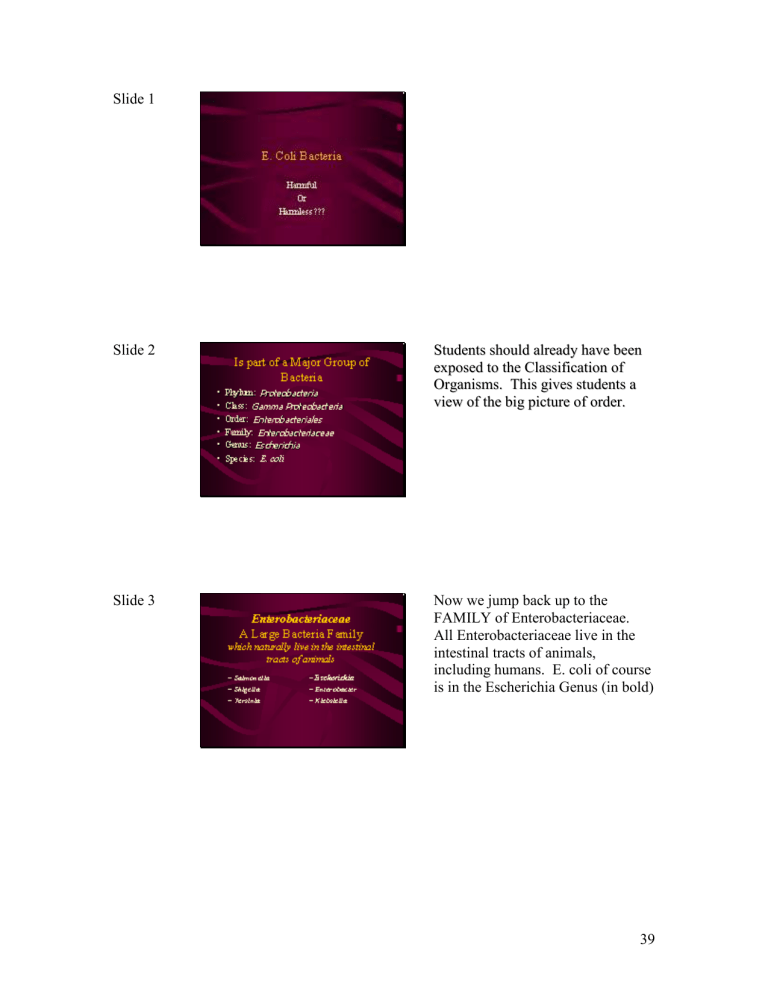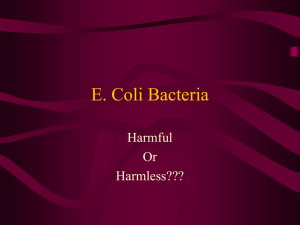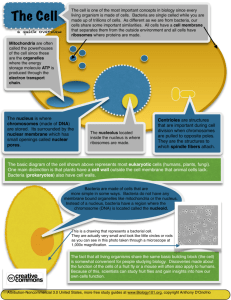14-LESSON PLAN 5b.doc

Slide 1
Slide 2
Slide 3
S t t u d e n t t s s s h o u l l d a l l r r e a d y h a v e b e e n e x p o s e d t t o t h e C l l a s s s s i i f f i i c a t t i i o n o f
O r r g a n i i s s m s s .
.
T h i i s s g i i v e s s s s t t u d e n t t s s a v i i e w o f f t t h e b i i g p i i c t t u r r e o f f o r r d e r r .
.
Now we jump back up to the
FAMILY of Enterobacteriaceae.
All Enterobacteriaceae live in the intestinal tracts of animals, including humans. E. coli of course is in the Escherichia Genus (in bold)
39
Slide 4
Slide 5
Slide 6
E. coli.
Scanning E.M. Shirley
Owens. Center for Electron Optics.
Michigan State University.
NOW WE UNDERSTAND THE
“E” of E. coli bacteria!
40
Slide 7
Slide 8
Slide 9
Why we wash our hands!!!!!!
This is why we test water for e.coli concentrations in drinking water and at swimming lakes and rivers.
Negative E.coli strains have injured and killed people through spinach, tomato and hamburger consumption.
41
Slide 10
Slide 11
Slide 12
Low-temperature electron micrograph of a cluster of E. coli bacteria, magnified 10,000 times.
Each individual bacterium is oblong shaped.
NOTICE how the deadly mutation of E.coli is labeled
42
Slide 13
Slide 14
Slide 15
43
Slide 16
Slide 17
Slide 18
ANTIBODIES
44
Slide 19
How can antibodies help with detection of Bacteria & Viruses?
• Antibodies are protein molecules, usually developed by the immune system in mammals.
• The immune system uses the antibodies to identify and neutralize bacteria and viruses.
• For every bacteria or virus there is an antibody to identify & neutralize that bacteria or virus.
Slide 20
What if………
• We use the antibody to find the bacteria or virus……….
BUT…
•
How will we know that the antibody found the bacteria/virus????
Slide 21
45
Slide 22
Slide 23
Slide 24 Analyte is the liquid to be tested and is put on the application membrane.
46
Slide 25
Slide 26
Slide 27
.
How does this work if it’s meat at the meat packing plant?
47
Slide 28
Slide 29
Slide 30
Analyte is the liquid to be tested and is put on the application membrane.
Analyte is the liquid to be tested and is put on the application membrane.
Analyte is the liquid to be tested and is put on the application membrane.
48
Slide 31
Slide 32
Slide 33
Analyte is the liquid to be tested and is put on the application membrane.
Analyte is the liquid to be tested and is put on the application membrane.
Analyte is the liquid to be tested and is put on the application membrane.
49
Slide 34
Current dilemmas & challenges?
• How do we get industry interested in manufacturing biosensors?
• Should biosensors be legislated as mandatory at food processing plants? How could this save or cost industry in dollars?
• Or should biosensors be left to personal use for an individual to have on hand an home?
• Others?
Slide 35
50






